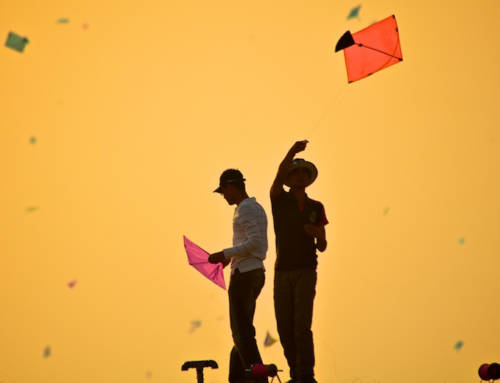History of kites
These designer kites were invented in China, where materials ideal for kite building were promptly accessible: silk fabric for sail material; fine, high-tensile-strength silk for flying line; and resilient bamboo for a strong, lightweight framework. The kite has been claimed as the invention of the 5th-century BC Chinese philosophers Mozi (also Mo Di) and Lu Ban (also Gongshu Ban). By 549 AD paper kites were unquestionably being flown, as it was recorded that in that year a paper kite was used as a message for a rescue mission. Ancient and medieval Chinese sources describe kites being used for measuring distances, testing the breeze, lifting men, signaling, and communication for military operations. The earliest known Chinese kites were flat (not bowed) and often rectangular. Later, tailless kites incorporated a stabilizing bowline. Kites were decorated with mythological motifs and legendary figures; some were fitted with strings and whistles to make musical sounds while flying. From China, kites were introduced to Cambodia, Thailand, India, Japan, Korea and the western world.
After its introduction into India, the kite further evolved into the fighter kite, known as the “Patang” in India, where thousands are flown every year on festivals such as Makar Sankranti. Makar Sankranti is a Hindu festival celebrated in almost all parts of India, Nepal, and Bangladesh in many cultural forms. It is a harvest festival that falls on the Magh month of the Nepali calendar (Hindu Solar Calendar). Makar Sankranti marks the transition of the sun into the zodiacal sign of Makara (Capricorn) on its celestial path. The day is also believed to mark the arrival of spring in India and the Magh month in Nepal and is a traditional event. Makar Sankranti is a solar event making it one of the few Hindu festivals which fall on the same date in the Nepali calendar every year: 14 January, with few exceptions when the festival is celebrated on 15 January.
Creative kites were known throughout Polynesia, as far as New Zealand, with the assumption being that the knowledge diffused from China along with the people. Anthropomorphic kites made from cloth and wood were used in religious ceremonies to send prayers to the gods. Polynesian kite traditions are used by anthropologists get an idea of early “primitive” Asian traditions that are believed to have at one time existed in Asia.
Kites were late to land in Europe, despite the fact that windsock-like banners were known and used by the Romans. Stories of kites were first brought to Europe by Marco Polo towards the end of the 13th century, and kites were brought back by sailors from Japan and Malaysia in the 16th and 17th centuries. Although they were initially regarded as mere curiosities, by the 18th and 19th centuries kites were being used as vehicles for scientific research.
In 1750 Benjamin Franklin published a proposal for an experiment to prove that lightning was caused by electricity by flying a kite in a storm that appeared capable of becoming a lightning storm. It is not known whether Franklin ever performed his experiment, but on May 10, 1752, Thomas-François Dalibard of France conducted a similar experiment using a 40 feet (12 m) iron rod instead of a kite and extracted electrical sparks from a cloud.
Franklin understood the threats of utilizing conductive bars and rather utilized his son to fly the kite. This enabled him to remain on the ground and the kite was likely to electrocute him. According to the legend, Franklin kept the string of the kite dry at his son’s conclusion to insulate him while he was permitted to get wet in the rain to give conductivity.
A house key belonging to Benjamin Loxley was attached to the string and connected to a Leyden jar, which Franklin assumed would accumulate electricity from the lightning. The kite was not struck by noticeable lightning; had it done as such, Franklin would more likely than not have been executed. Be that as it may, Franklin noticed that the strings of the kite were repulsing each other and deduced that the Leyden jar was being charged. He moved his hand close to the key a short time later because as he had estimated, lightning had contrarily charged the key and the Leyden jar, demonstrating the electric idea of lightning.











Leave a Reply